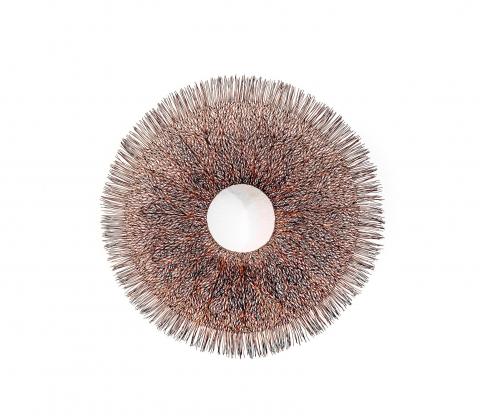BLAZE, 2003
BRONWYN OLIVER
copper
100.0 cm diameter
Christine Abrahams Gallery, Melbourne
Private collection, Sydney (commissioned from the above)
Blaze, 2003 is as its creator was: an awe-inspiring, radiating comet of energy, both delicate and fleeting. Hypnotic and extraordinarily intricate, Blaze is constructed of a matrix of welded copper threads in Bronwyn Oliver’s signature mature style. Oliver was a unique sculptor in the Australian art world, having more stylistic and technical affinity with members of the New British Sculpture movement under whom she had studied at the Chelsea School of Art between 1982 – 84, such as Richard Deacon and Martin Puryear. Her art is completely confident in style and execution, lyrical in its sensibility and loyal to its inner logic.
A famously fastidious artist, Oliver was renowned for her work ethic, working tirelessly to breathe life-force into her industrial materials, endowing them with a surprisingly organic appearance. Oliver’s choice of materials is not to be overlooked. She was remarkable in having chosen physically demanding and long-lasting metals at a time when many of her peers were toying with ephemeral materials and forms. Having moved away from the cane and paper works that had won her early critical acclaim, Oliver devoted her work almost entirely to the medium of copper, creating filigree nets of repeating teardrop forms. The finesse of these closely knit patterns invites quiet contemplation and appreciation. Oliver’s forms are governed by a series of apparent physical contradictions which reveal themselves to an attentive viewer – between fragility and strength, simplicity and intricacy, uniqueness and universality.
Blaze is no exception to this complex game of physical contradictions. Its forms are majestic and theatrical. Bordered by a series of overlapping spikes radiating from its centre, Blaze inspires outward awe and appreciation from a distance, much like the radiating warmth of our sun. The finely wrought net that comprises the central ring of this artwork seems to absorb the gaze into the void within its centre. This centrifugal force, drawing light, depth and attention within the centre of the work is counteracted by the elaborate centripetal force created by Blaze’s radiating spikes.
Oliver revelled in the structural formation of her works. Her unique formal vocabulary appeared to be inspired by the archetypal shapes of the natural world: pods, spirals, tendrils and vessels. Throughout her career these forms seem to evolve with the internal development that would have delighted 20th century Swiss art historian Heinrich Wöfflin. However, Oliver’s ideas did not stem from the observation of natural forms, instead her practice took for its subject the act of creation itself – a sincere investigation of her materials and the way she chose to manipulate them. In reality, these organic, universal forms that seem to encapsulate metaphorical potential of life were born of Oliver’s painstaking process of welding and forging. The result is self-assured, sincere and bears lasting power.
LUCIE REEVES-SMITH
